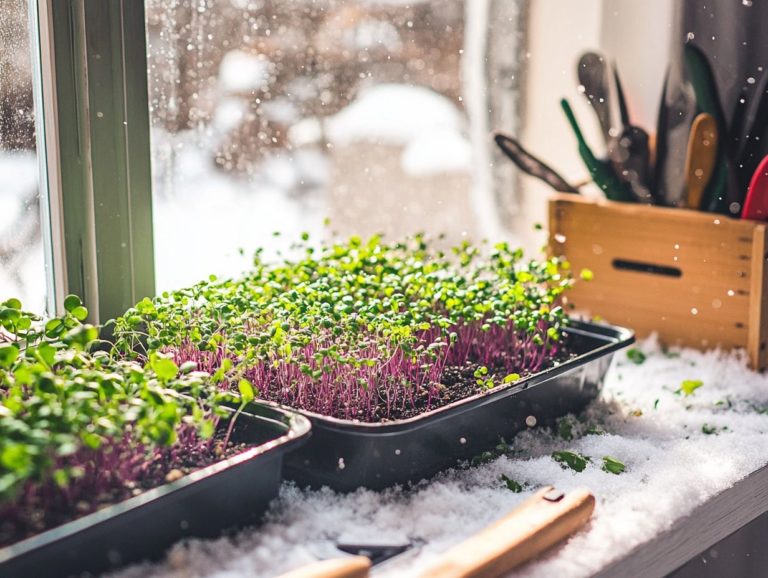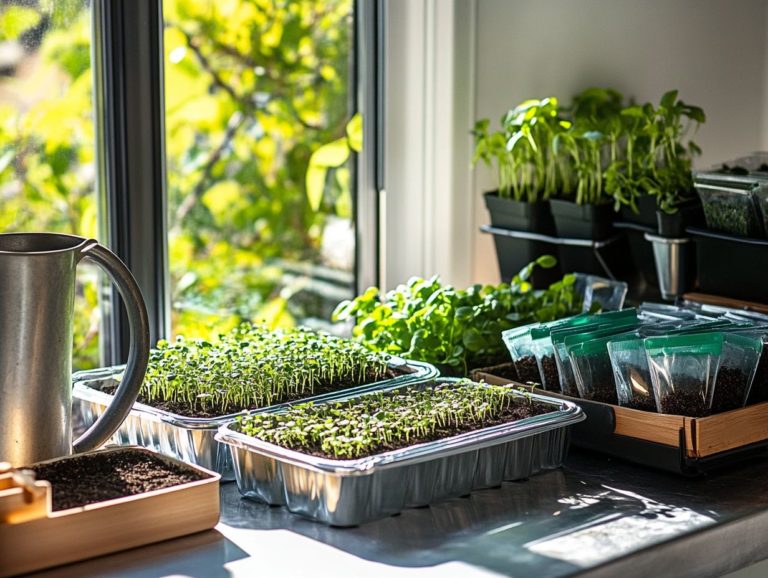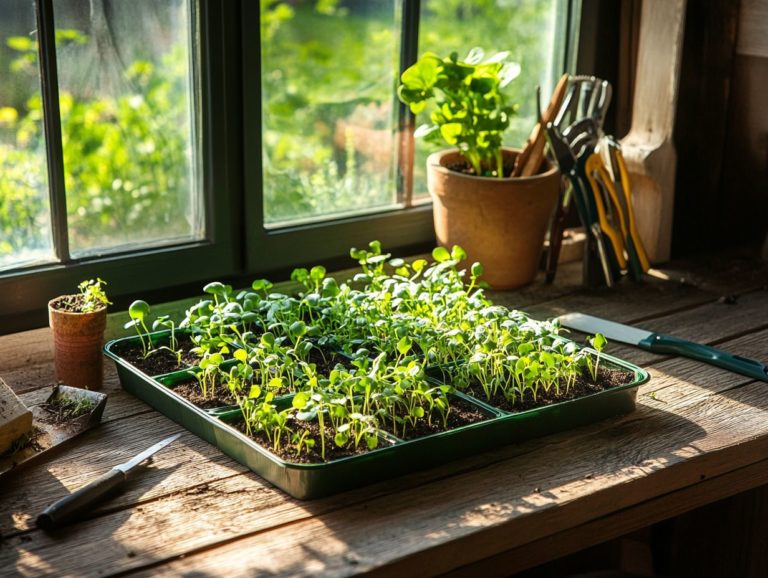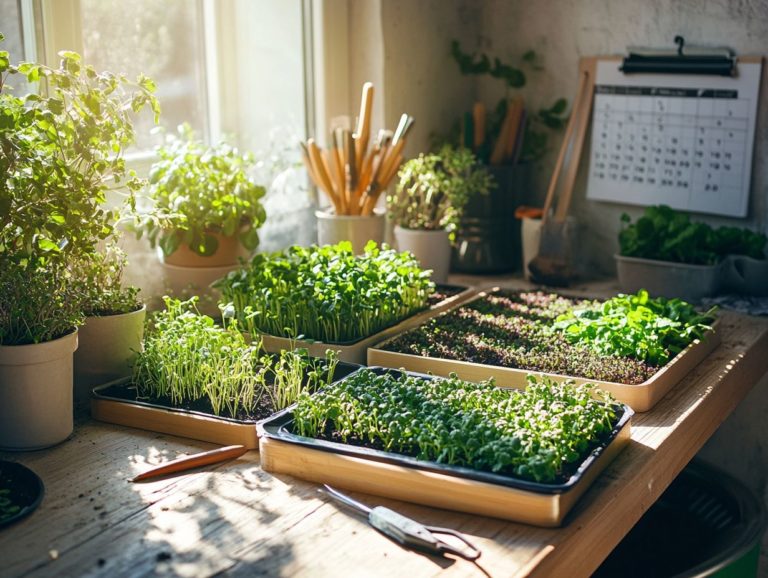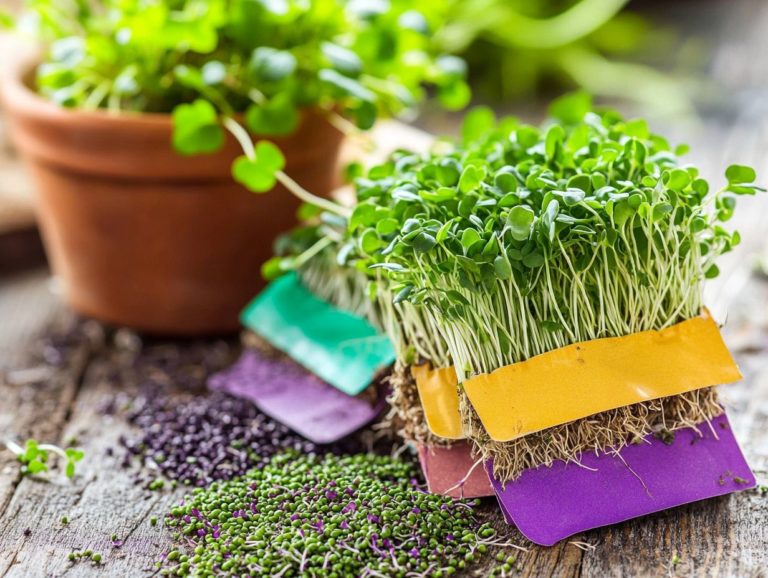How to Start a Microgreen Garden for Beginners
Microgreens are small yet mighty plants, brimming with nutrients that can elevate your meals and refine your gardening prowess. They are an excellent choice for any dish.
They are remarkably easy to grow, requiring minimal space. This makes them an ideal choice for beginners eager to dive into the world of gardening. Let s explore the exciting world of microgreens together, outlining the benefits of growing them and the essential supplies you will need for small gardens in cities.
From selecting the perfect varieties, like spinach and mustard greens (from the Brassica family), to troubleshooting common challenges, you will find comprehensive guidance at every stage to cultivate your own vibrant microgreen garden. Get ready to add fresh flavors to your meals today!
Contents
- Key Takeaways:
- What are Microgreens?
- Choosing the Right Microgreens to Grow
- Supplies and Equipment Needed
- Preparing for Planting
- Planting and Caring for Microgreens
- Harvesting and Using Microgreens
- Troubleshooting Common Issues
- Frequently Asked Questions
- What are microgreens and why should I start a microgreen garden?
- How do I choose the right seeds for my microgreen garden?
- How much space do I need to start a microgreen garden?
- What kind of soil should I use for my microgreen garden?
- How often should I water my microgreens?
- When can I start harvesting my microgreens?
Key Takeaways:
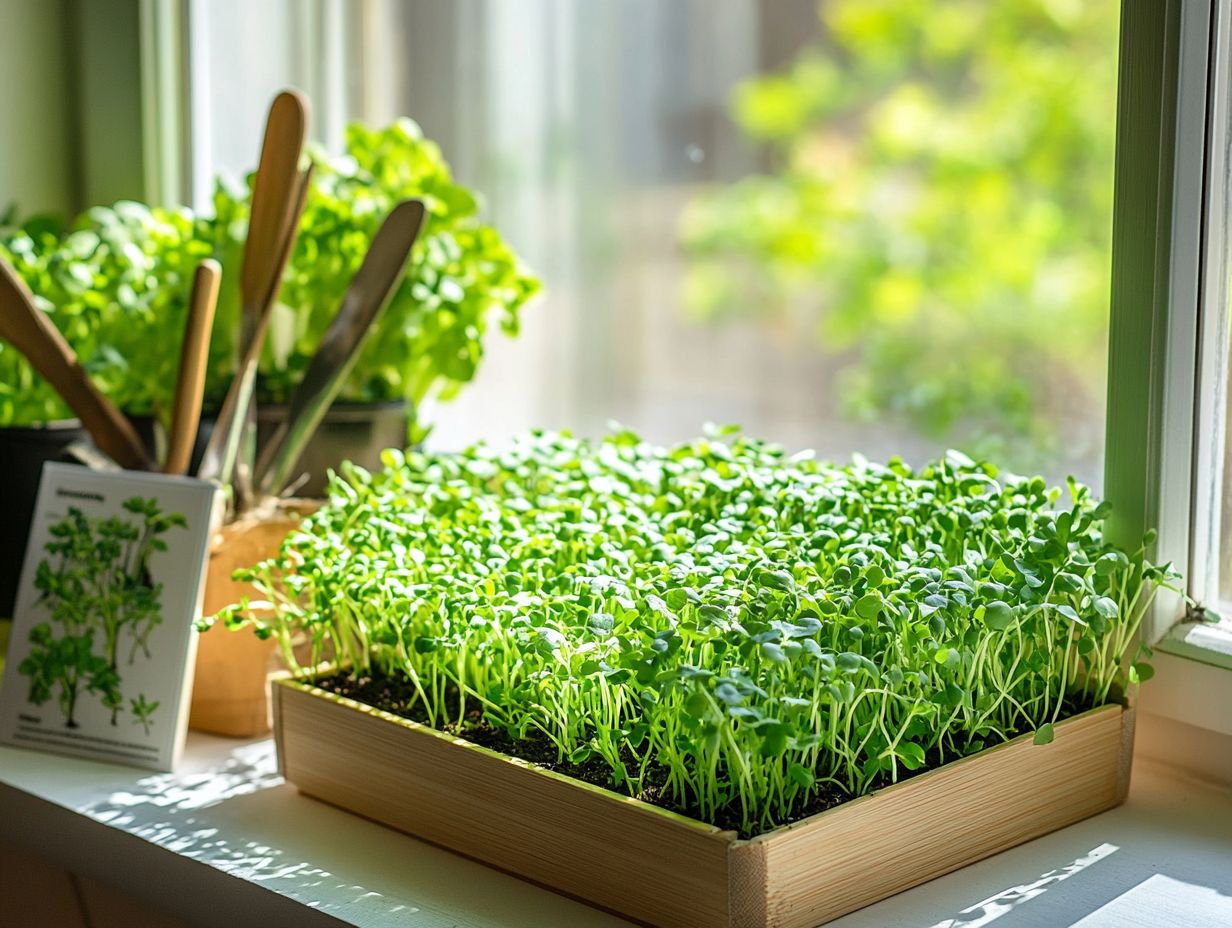
- Microgreens are young, nutrient-packed vegetable greens that are easy to grow and have numerous health benefits, especially for those following American dietary guidelines.
- When choosing microgreens to grow, consider factors such as space, climate, and personal preference in taste and variety.
- To start a microgreen garden, you will need basic supplies and equipment such as soil, containers, and seeds, along with essential tools for planting and caring.
What are Microgreens?
Microgreens are young, edible plants that you can harvest just after the first true leaves have emerged. They often thrive in home gardens. These petite greens offer a concentrated burst of nutrients, along with a wide array of health benefits, making them a sought-after choice for everything from raw eating to gourmet dishes, perfect for enhancing flavors in meals.
Varieties like spinach, radishes, and mustard greens (from the Brassica family) are particularly popular thanks to their rapid growth and bold flavors.
Definition and Benefits
Microgreens are not just a trendy garnish; they are young plants packed with nutrients that elevate the visual appeal of your dishes while delivering a concentrated punch of flavor and health benefits.
Research published in the *Journal of Agricultural and Food Chemistry* reveals that these tiny greens can boast up to 40 times the nutrients of their mature counterparts. They are a formidable addition to any meal, especially in a home garden. You will find high levels of vitamins C, E, and K, along with beneficial antioxidants that bolster your overall health, making them a great addition to your diet for raw eating and nutritious produce.
But it’s not just about nutrition these intense flavors can transform simple recipes, adding depth to salads, vegetable confetti, sandwiches, and smoothies. By incorporating these vibrant shoots into your cooking, you not only enhance your culinary creations but also embrace a wealth of nutritional advantages that significantly contribute to a balanced diet.
Choosing the Right Microgreens to Grow
Selecting the right microgreens for your home garden can profoundly enhance your culinary adventures, boost health benefits, and elevate your overall gardening satisfaction.
Consider several key factors, including your local climate and the space you have at your disposal. This thoughtful selection process will help you choose varieties that not only flourish in your environment but also delight your palate.
Factors to Consider
When you are choosing microgreens, key factors come into play, such as the type of growing medium and how much sunlight you can capture on your sunny windowsill. The quality of the seed packets you select should include fast-growing varieties. Understanding these elements is crucial for cultivating a thriving crop.
For growing mediums, you will find options that range from rich soil blends infused with organic matter to sophisticated hydroponic systems, each offering unique advantages. It is vital to choose a medium that retains moisture while also ensuring proper aeration, especially in container gardening setups. (Hydroponic systems use water and nutrients instead of soil to grow plants.)
Regarding drainage, always opt for containers with multiple holes at the bottom. This allows excess water to escape, helping you avoid the dreaded root rot.
Do not overlook the importance of high-quality seed packets. Seek out reputable brands that offer fresh, viable seeds specifically suited for microgreen varieties. This attention to detail will significantly boost your success rate in germination and growth.
Supplies and Equipment Needed
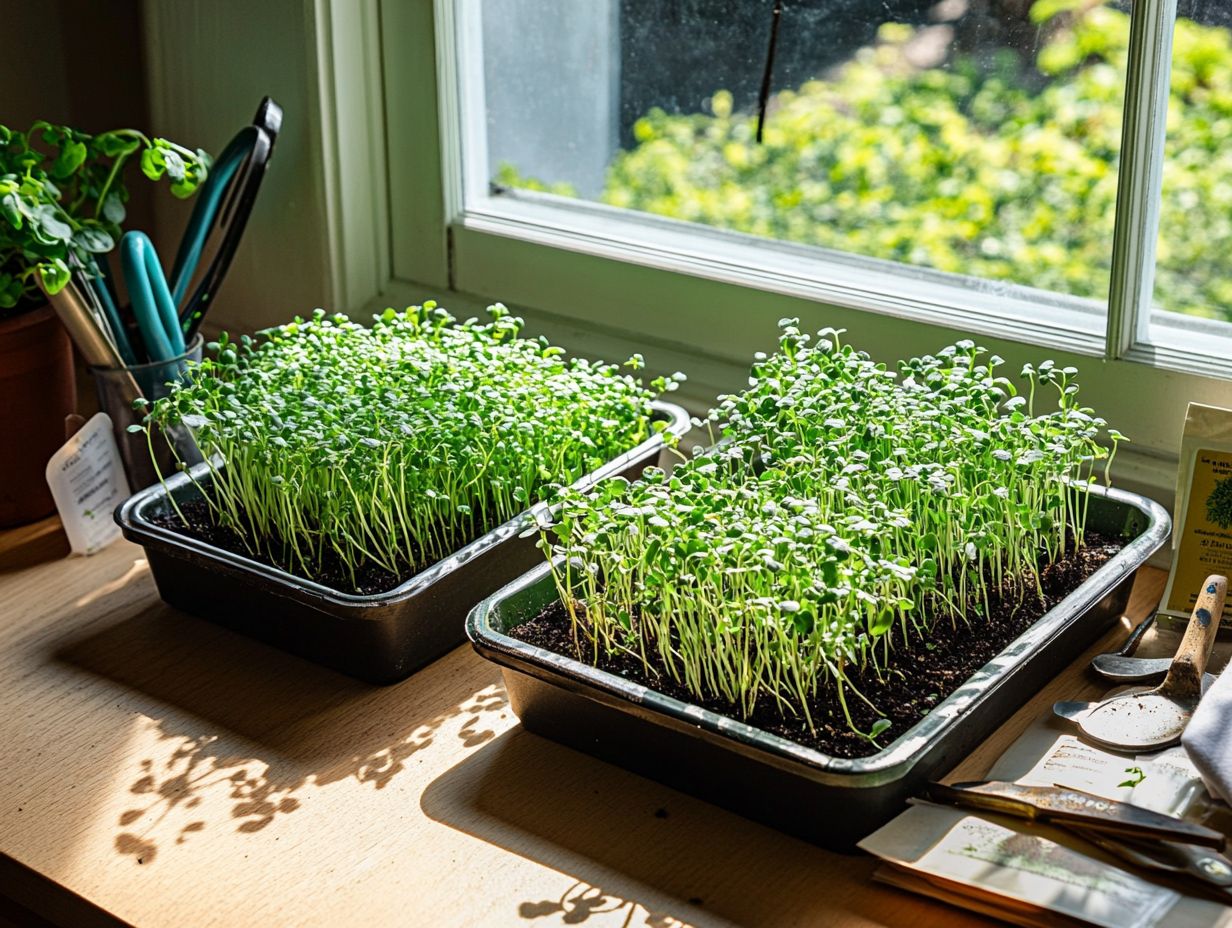
To successfully cultivate microgreens, gather the right supplies and equipment tailored for growing plants in pots or other containers. This will allow your seedlings to flourish in a controlled environment.
Key items you ll want for your indoor gardening include:
- Suitable containers
- High-quality growing medium
- Efficient watering tools
- Adequate light sources
These items will help foster optimal growth.
Essential Tools and Materials
Essential tools and materials for cultivating microgreens include containers with drainage holes, quality soil or potting mix, and effective light sources. These elements ensure your microgreens thrive.
For optimal growth, consider using seed trays designed to give your seedlings the space they need. Standard options include LED grow lights, which mimic natural sunlight and can be adjusted for different microgreen varieties. For a more budget-friendly alternative, compact fluorescent lights are a great choice. Additionally, exploring techniques for growing microgreens year-round can enhance your gardening success.
In terms of soil, you can use alternatives like coconut coir or peat moss, both of which offer excellent drainage and aeration. Get creative! Recycled plastic containers or repurposed trays can serve as effective growing vessels, providing a sustainable approach to your indoor gardening experience.
Preparing for Planting
When preparing to plant microgreens, focus on these crucial steps:
- Select high-quality soil.
- Choose the right containers with proper drainage holes.
- Sourcing viable seeds specifically suited for urban farming.
By paying attention to these elements, you create an environment that fosters successful growth at every stage of the process.
Soil, Containers, and Seeds
Choosing the right soil, containers, and seeds is essential for your microgreen cultivation. Focus on drainage holes and an appropriate growing medium for healthy root development.
Different types of soil, such as coconut coir, peat moss, or a nutrient-rich soil blend enhanced with compost, can provide ideal nourishment for various microgreen varieties. To understand how these factors influence growth, check out the science behind microgreen growth. Ensure your containers have drainage holes to prevent waterlogging, which means the soil is too wet and can harm plant roots, leading to mold growth and stunted seedlings.
When selecting seeds, opt for varieties known for their rapid growth and delightful flavor, such as arugula, radish, or pea shoots. Mixing your growing medium means combining equal parts of soil and organic matter for a light, aerated texture that supports optimal moisture retention and ensures easy access to nutrients for your microgreens. To enhance your growing techniques, consider learning How to Use Hydroponics for Microgreens.
Planting and Caring for Microgreens
Growing microgreens is an exciting and straightforward adventure for everyone! Start by sowing the seeds with precision, followed by right maintenance practices.
This attentive care fosters their growth and unlocks a myriad of health benefits. It also enhances their flavor profile, allowing for exciting flavor changes that lead to a delightful culinary experience.
So gather your supplies and dive into the world of microgreens today!
Step-by-Step Guide
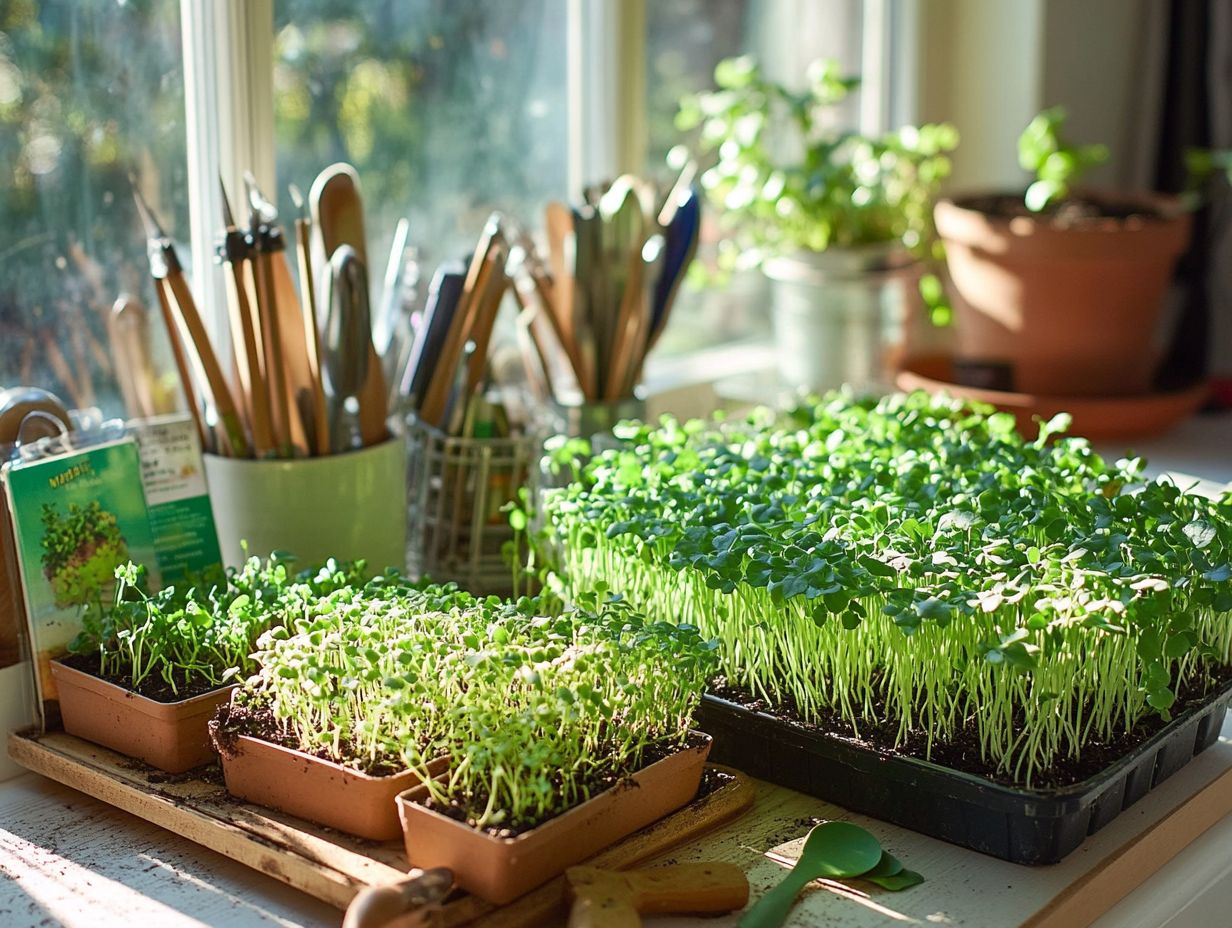
Follow this step-by-step guide to successfully plant and care for your microgreens. Each stage contributes to their growth and optimal health benefits.
From selecting the right seeds to mastering lighting conditions, every detail plays a crucial role in maximizing yields and enhancing flavor. Start by preparing a nutrient-rich soil mix that is well-aerated and free of contaminants. For a comprehensive approach, refer to our step-by-step guide to sowing microgreens. After all, healthy soil is the bedrock of thriving microgreens.
- Next, gently sow the seeds at the recommended density. Lightly cover them with soil to retain moisture.
- Keep a careful watch on light exposure, adjusting it based on the specific microgreen variety you re cultivating. Some flourish under direct sunlight, while others prefer a shadier environment.
- Water consistently, ensuring the soil remains moist but not waterlogged to avoid root rot.
- Monitor the growth rate closely and adjust humidity levels as needed to create an ideal environment for your microgreens to flourish.
Harvesting and Using Microgreens
Harvesting and utilizing microgreens to their fullest potential requires a keen awareness of the optimal timing for their collection. It s equally important to explore innovative recipes that showcase their health benefits and accentuate the delightful nuances in flavor.
Tips for Harvesting and Recipes to Try
Here are some valuable tips for harvesting microgreens. These include effective harvesting techniques, along with delectable recipes that highlight their health benefits and elevate your meals.
Microgreens are a true powerhouse of flavor and nutrition, making them an exceptional addition to any dish. To ensure peak freshness, aim to harvest them at two to three inches tall, just before they start developing true leaves. This height is ideal for dishes packed with nutritious produce.
Use clean, sharp scissors to snip them just above the soil line. Don t forget to rinse them gently to remove any lingering soil before using.
Incorporating these vibrant greens into your culinary repertoire is effortless. Toss them into salads, crown your soups, or blend them into smoothies. They are essential staples for anyone who values health and flavor in the kitchen.
Troubleshooting Common Issues
Let s tackle common issues head-on to keep your plants thriving! Troubleshooting common issues with microgreens demands keen attention to swiftly identify problems like pests and diseases that could jeopardize the health and vitality of your home gardening endeavors.
Recognizing these threats early on is crucial to ensuring the success of your green oasis.
How to Address Pests and Diseases
Addressing pests and diseases in your microgreens requires careful watching and a proactive approach. This ensures your home gardening remains healthy and productive.
Implement regular checks for signs of damage or disease to significantly aid in early detection. Use methods like crop rotation and companion planting, which means growing different plants close together for mutual benefits. This not only reduces pest attraction but also fosters a balanced ecosystem in your garden.
Use organic pest control methods like neem oil and insecticidal soap to manage infestations without harming beneficial organisms that work in your favor. Ensuring proper air circulation and avoiding overwatering will help prevent common fungal diseases.
By incorporating these strategies, you can create a thriving environment for your microgreens, ultimately leading to a bountiful and sustainable harvest.
Frequently Asked Questions
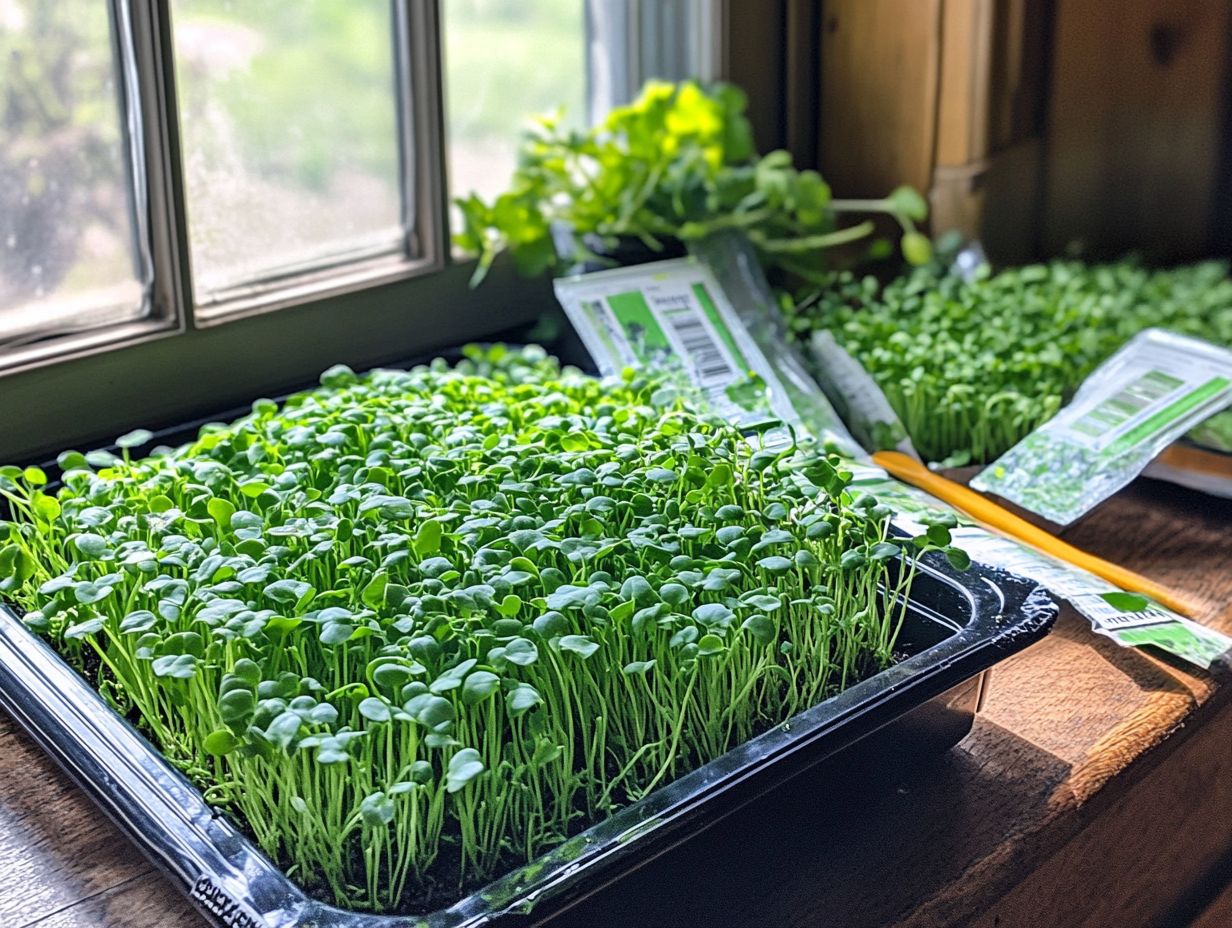
What are microgreens and why should I start a microgreen garden?
Microgreens are small, edible seedlings of vegetables and herbs. They are packed with nutrients and can be easily grown at home, making them a great addition to any diet.
How do I choose the right seeds for my microgreen garden?
You can choose any type of vegetable or herb seeds for your microgreen garden. However, it is recommended to start with easy-to-grow varieties such as broccoli, kale, or basil.
How much space do I need to start a microgreen garden?
You don’t need a lot of space to start a microgreen garden. A small tray or container on a windowsill works perfectly for growing a variety of tasty microgreens.
What kind of soil should I use for my microgreen garden?
Use good potting soil or a seed starting mix for your microgreens. Don’t use regular garden soil; it may have pests or harmful bacteria.
How often should I water my microgreens?
Keep your microgreens consistently moist but not soggy. Water them once a day or as needed to keep the soil damp.
When can I start harvesting my microgreens?
Harvest your microgreens when they reach about 1-2 inches tall, usually 1-2 weeks after you plant them. Use clean scissors to snip just above the soil line and enjoy the fresh, nutrient-packed flavor in your meals!

